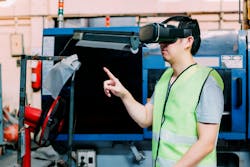It seems like almost every day a new technology hits our radar, and that’s certainly true for EHS professionals. Innovations and new tools are emerging that are designed to keep the workforce safe, or at least safer.
Many of these new solutions focus on providing more visibility into the myriad processes that comprise an employee’s workflow, whether it be applications that can determine if machinery is operating correctly, or devices that can assist employees in performing their jobs in a more ergonomically correct manner, or autonomous vehicles such as drones that can provide aerial views of particularly danger areas. On a broader scale, both internal and external environments can be improved as the result of software which can take a variety of measurements, analyze data and often suggest action steps.
While much of the technology has been focused on identifying risk, future applications will be more proactive about predicting risk. In fact, a recent survey from analyst firm Verdantix found that 44% of respondents ranked proactive risk management as either the first or second most influential factor driving their budgets.
This proactive perspective is especially useful to address one of the areas that is increasingly coming under the EHS umbrella, namely ESG (environmental, social and governance). While publicly listed companies must report Scope 1 and 2 emissions, Scope 3 will become mandatory within the next year. Verdantix points to such technologies as continuous emissions monitoring systems (CEMS), carbon management software, digital product passports, digital permits to work, and IoT sensors for environmental monitoring as being useful for ESG compliance.
Another tech trend that is beginning to show some inroads is the use of connected worker solutions. These technologies include virtual reality (VR) and augmented reality (AR). However, according to Verdantix, the business case of these technologies is not as promising as companies thought. The Verdantix analysts note, in their EHS tech roadmap, that “cost, ergonomic issues and poor image quality have all contributed to [VR’s] slow uptake by EHS executives.”
On the other hand, technological advancements can provide a good return on investment when it comes to reducing injuries from musculoskeletal disorders (MSDs). An October 2023 survey from the National Safety Council (NSC) found that passive exoskeletons have been shown to reduce muscle activity by up to 40% and, in one case study, decreased worker fatigue by 45% while boosting organizational output by nearly 10%.
The NSC adds that wearable sensors, which can provide real-time feedback, can reduce back injuries caused by poor posture, over-reaching and improper lifting.
Wearables and Sensors
Other wearables such as smart clothing can also monitor body movements and provide feedback. Wearables have been shown to reduce worker strain in both warehouses and manufacturing in general. One example are gloves that are able to reduce potentially harmful hand movements by up to 20% within three months.
Smart helmets are another example of how sensors, and in this case augmented reality, can be built into a product. According to the American Society of Mechanical Engineers, smart helmets have been linked to improvements in productivity and workplace safety. One of the ways sensors can do this is by using a health monitoring function which tracks focus and cognitive states as well as vital statistics. The data can identify if a worker is too tired or unfocused to safely perform a job.
Wearables can also monitor the environment. For industries such as chemical refining, oil & gas, and others that involve exposure to toxic substances, these devices can track, report and even alert emergency teams if necessary.
As these sensors are showing, it’s the collection and analysis of data that is central to preventative actions. Here are some examples of companies that are using technology to improve safety in their workplaces:
ADVICS North America
Using sensors and software, this manufacturer of automotive brake systems found a 23% reduction in overall risk by finding the optimal configuration of a conveyor. The improved configuration led to a 66% reduction in right arm risk.
Using another type of software to improve ergonomics, the company experienced a 61% reduction in spine risks and a 41% reduction in shoulder risk.
Kenco Logistics
This third-party logistics provider (3PL), which manages more than 90 facilities, wanted to improve safety for pickers at its most physically demanding warehouses. With employees wearing a clip-on device on their shirt, the sensor provides both audible and vibration feedback alerting employees of hazardous movements they might make. The feedback from the sensor has resulted in a 22% reduction of hazardous movements.
Peugeot
This auto manufacturer uses a virtual reality safety program, providing interactive 360-degree movies. The company reports that the more than 40,000 workers who have used this training retained information better and were more engaged.
Evaluating Technology
As the current technologies improve and new ones are introduced, companies face the question of how best to evaluate safety solutions. The American Society of Safety Professionals (ASSP) offers these tips from Jeff Hoyle, director of ergonomics services at The Ergonomics Center at North Carolina State University:
Cost: As these technologies become more widely available, costs will decrease and more companies will realize a positive return on investment, including greater injury prevention.
Scalability: Many of these technologies are designed to assess a single person, such as computer vision technology and some wearables.
Data accuracy: Many companies claim to produce accurate data, but Hoyle has reservations about claims because of his own pilot testing of computer vision systems. “There’s a lot of promise, but additional validation testing is needed,” he notes.
Data security and privacy: Videos of employees and risk metrics must be protected.
Data processing power: The amount of data generated is enormous and the processing power needed to analyze it can be expensive, Hoyle says.
Looking to the Future
To help companies continue to navigate the safety technology frontier, the NSC has created a research initiative called Work to Zero. It has defined more than 100 EHS technologies that the organization feels are effective at reducing risks. It has created a searchable collection of information, called Safety Tech ai, that includes a variety of mediums to provide information about trends.
With the exponential growth rate of technological development, it is safe to say that EHS professionals will continue to uncover and benefit from increasingly innovative ways to protect workers.
About the Author
Adrienne Selko
Senior Editor
Email [email protected]
Adrienne Selko is also the senior editor at Material Handling and Logistics and is a former editor of IndustryWeek.

